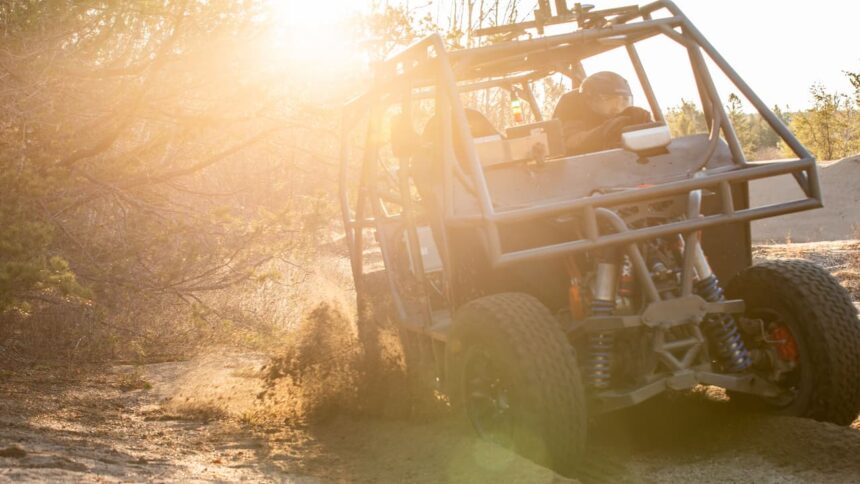Created by Potential Motors, the idea is to use a car’s in-built camera to anticipate forthcoming road conditions and improve its responsiveness to the situation
Published: 05 Jun 2024
It’s an interesting time to be a driver right now, with the advancement of electric vehicle technology and the integration of AI looming large. But have you ever wondered how these developments could shape off-roading in the future, and perhaps if those technologies could then be applied to daily driving?
To find out just that, we sat down with the CEO of Potential Motors, Sam Poirier. His company has spent the last few years exploring new ways of how a vehicle could react to different surfaces and terrains using something most modern cars already have as standard: cameras.
Advertisement – Page continues below
“At the core of what we do is to make use of a vehicle’s onboard camera(s) to essentially be able to do terrain analysis. We use them to look ahead at any shifts in terrain, like if you’re passing over an area of low or high friction, or if you’re getting into an environment with lots of bumps. We then use this information to better inform elements like the pre-existing traction or suspension control.”
But why does Poirier believe this technology is worth investing so much time and effort in?
“In general if you look at road accidents, a lot of them are due to human error, but a good portion is still down to extreme circumstances such as weather. A big reason why weather may cause an accident, for instance, is because the driver or the vehicle doesn’t respond in time to a change in conditions. This is one of the areas where we see our technology helping.
“By being able to solve the most ‘extreme’ off-road problems, we can translate that to help us solve the more commonly occurring things. It means that we can help people who both want to go on long expeditions across countries and those who want to teeter around town.”
Advertisement – Page continues below
The obvious question to ask at this point is if Poirier and his team have applied their work to any cars to get some real feedback. As it happens, they’ve gone one better and built two vehicles from scratch to get a full understanding of the implementation process.
“The first vehicle is called the ‘P Zero’, which is a four-motor EV. We did the design and build of it from the ground up so we could have full control of its software. In that case, we’re able to test really advanced things like the limit of torque vectoring based on real-time information.
“The second vehicle is called the ‘KRX’, which is a traditional side-by-side vehicle like a dune buggy. In the KRX, drivers have two sets of controls: the first is for the drive line, which determines if the vehicle is two or four-wheel drive, and when the locking differentials are activated. The second is for the suspension, determining how soft or firm it is.
“In the case of the KRX, instead of looking at what comes next in terms of control, we’re exploring how we can improve the overall driving experience in the present day.
Thank you for subscribing to our newsletter. Look out for your regular round-up of news, reviews and offers in your inbox.
Get all the latest news, reviews and exclusives, direct to your inbox.
“We want to focus on how we can layer on the expertise of someone who’s driven these types of cars for decades through technology, and what that means is to use automation to figure out the terrain ahead and make those drive lines or suspension switches automatically. It feels very much like going from a manual to an automatic transmission and means the vehicle is almost always optimised for whatever terrain it is that you’re driving on.”
But as with any complicated piece of tech, Poirier and his team have encountered some big hurdles along the way.
“Figuring out how to pull out useful information from a vehicle’s camera was the first challenge. It’s only really the technology that’s been around for the last decade or so that’s allowed us to make this development, and that has ultimately happened because we’ve seen breakthroughs with AI and computer vision.
“Another is that all this technology is based on data – something we think of as the ‘fuel’ which allows the tech to do well in the first place. Many OEMs that we work with at present are looking to solve the same problem.
“Today they make use of technology that’s generally been the same since the Eighties, which is using the wheel to be able to roll over terrain to understand what it is you’re driving on. They’re looking at how we can make that proactive instead of reactive, and a good way to do that is by using a car’s built-in camera to understand the data for what’s coming ahead of you in real-time.”
So, should Potential’s technology prove a success and the demand for it is there, how can we expect to see it incorporated into vehicles and sold?
“This will depend on the OEM or carmaker that you’re purchasing from, but it makes things very interesting. Because there are so many options for how software is being integrated into cars right now; an example could be the ‘conflict’ around BMW’s heated seats policy.
“For the most part, we see this technology as something that just comes baked directly into the car. But when it comes to the more complex off-road technologies, that’s something that could for example be a switch that you toggle on for a weekend’s off-road adventure or week-long road trip. I think there will be options for how this is put in front of the customers.”
An interesting development no doubt, but is it something you’d seriously consider in your next car purchase? Let us know in the comments…











